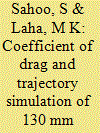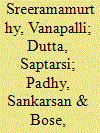| Srl | Item |
| 1 |
ID:
136038


|
|
|
|
|
| Summary/Abstract |
In the present study, the drag variation and trajectory elements estimation of a supersonic projectile having two different nose shapes are made numerically. The study aims at finding the coefficient of drag and shock wave pattern for 130 mm artillery shell fitted with recovery plug or with fuze, when travelling at zero angle of attack in a supersonic flow of air. The coefficient of drag (CD) obtained from the simulation is used as an input parameter for estimation of trajectory elements. The numerical results, i.e., the coefficient of drag at different Mach numbers and trajectory elements are validated with the data recorded by tracking radar from an experimental firing. Based on numerical results and data recorded in experimental firing, the coefficient of drag in the case of the shell with recovery plug is 2.7 times more than for the shell with fuze. The shock wave in the case of the shell with recovery plug is detached bow shock wave, whereas in the case of a shell with fuze, the shock is attached. The results indicate that the coefficient of drag increases with detached shock wave and an increase in the radius of the shell nose. Good agreements were observed between numerical results and experimental observations.
|
|
|
|
|
|
|
|
|
|
|
|
|
|
|
|
| 2 |
ID:
136040


|
|
|
|
|
| Summary/Abstract |
Source localisation is a method to estimate position of a source. In case of acoustic source localisation (ASL), the location of sound source is estimated using acoustic sensors such as a microphone. In case of ASL, time difference of arrival (TDOA) from each pair of microphones is estimated. For any pair of microphones, the surface on which the TDOA is constant is a hyperboloid of two sheets. Then the source location is estimated at the point where all associated hyperboloids most nearly intersect. This concept has been used in our range in finding the point-of-burst of artillery shell using an array of sensors. In this paper, a simulation model has been developed to examine the applicability of acoustic source localisation for determining point-of-burst of artillery shells. The randomness in the model has been incorporated in terms of gustiness of downrange sea wind. The result of the simulation has been validated with trajectory data of projectiles tracked by radar. Finally, an acoustic sensor array-based setup has been developed and used for localising point-of-bursts.
|
|
|
|
|
|
|
|
|
|
|
|
|
|
|
|